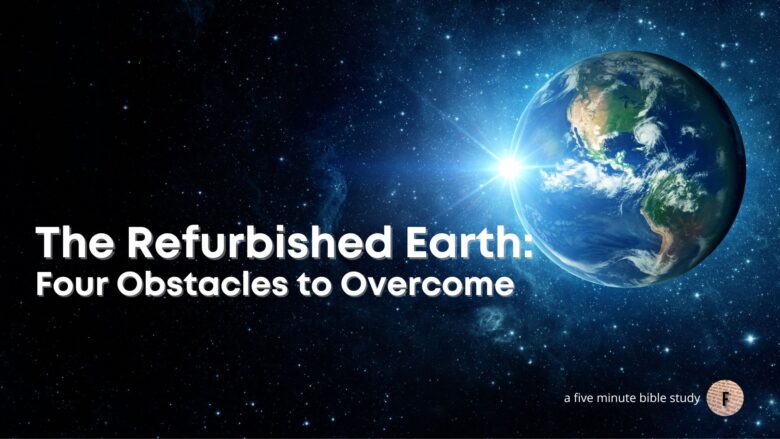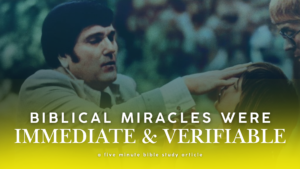The Refurbished Earth is the name some have given to denote an interpretation of scripture teaching that the earthly elements will not actually be completely burned up in the judgment day; rather, the earth will only be purified by fire, and what is left God shall refurbish into a glorious new heavens and new earth wherein the saints of God will dwell for all eternity. The alternative interpretation of judgment day and heaven has commonly been referred to as the traditional view: Jesus will come back in the clouds, annihilate the earth, and take the faithful back to heaven to dwell with God for all eternity. Over the last 100+ years, the traditional view has become accepted less and less, and the Refurbished Earth view has been accepted more and more. I will admit, I am one of those people swimming against the current who believes in the traditional view. I believe in the traditional view for several reasons, and four of those primary reasons are the foundation for this article.
Advocates of the Refurbished Earth viewpoint commonly cite three verses of scripture in defense: Romans 8:18-23; 2 Peter 3:10-13; Revelation 21:1-2. Emphasis is placed on a straightforward reading of these texts. However, I believe a straightforward reading of these texts will reveal several obstacles to a Refurbished Earth viewpoint. In pursuit of conciseness, I have limited this article to as few words as possible. Consider each obstacle presented below, and decide for yourself if the Refurbished Earth view is the most reasonable interpretation of scripture regarding the end-time judgment of the world.
1. The Refurbished Earth viewpoint has to get the “earth” literal in Revelation 21.
The problem with getting the earth to be literal in Rev. 21 is that virtually nothing in the contextual setting is literal. Almost everything is either symbolic or figurative. See the list below:
- The New Jerusalem is not literally a city but is symbolic of God’s people (v. 2, 9-10).
- God’s people are not literally a bride or the wife of the Lamb (v. 2, 9).
- The Lamb of God is not literally a lamb (v. 9, 14, 22-23, 27).
- God will not literally wipe tears from people’s eyes (v. 4).
- God’s name is not literally the first and last letters of the Greek alphabet (v. 6).
- The fountain with water is not a literal fountain with literal water but is symbolic of eternal life (v. 6).
- The one who thirsts does not literally thirst from being literally parched (v. 6).
- The lake of fire is not literally a lake with fire (v. 8).
- The second death is not literal death: separation of body and spirit (v. 8).
- The seven bowls are not literally seven bowls (v. 9).
- John was not literally carried away (v. 10).
- John was not literally standing on a literal high mountain (v. 10).
- The light of the holy Jerusalem is not literally precious stones (v. 11).
- The wall of the city with twelve gates are not a literal wall with a literal twelve gates (v. 12).
- The city does not literally have twelve foundations (v. 14).
- The city is not literally 12,000 furlongs/stadia or 1,500 miles in each direction (length, breadth, height) or 3,375,000,000 cubic miles in volume (v. 16).[1]
- The wall and city are not literally pure gold and clear glass simultaneously (v. 18).
- The Lord God Almighty and the Lamb are not literally a temple (v. 22).
- The Lamb is not literally light (v. 23).
- The Book of Life is not a literal book (v. 27).
Despite all of this very obviously figurative/symbolic talk, the refurbished earth interpretation arbitrarily interprets the new heavens and new earth as a literal earth that is literally “coming down out of heaven from God” (v. 2). The arbitrariness for such an interpretation is made obvious by one writer who advocates that the new heavens and new earth in Rev. 21 is a literal earth but then says, “When it comes to ideas of the next life, there is no reason to be thinking in terms of a place of literal ‘pearly gates’ and ‘streets of gold,’”[2] (emphasis mine).[3] I agree with this statement, but I would go one step further in saying that there is no reason be thinking in terms of a literal new heavens and new earth in Rev. 21:1 either.
2. The Refurbished Earth viewpoint has to water down the fiery (i.e., strong) language of 2 Peter 3.
The language of 2 Peter 3 is very strong, indicating that the present earth is going to be annihilated at the second coming of Christ. However, the refurbished earth viewpoint tries to interpret the strong language in this chapter in such a way as to avoid this conclusion. According to this viewpoint, Peter was not teaching annihilation of this old earth, but rather a purifying of it by fire. However, notice the following strong language from 2 Peter 3 that we have in focus here:
- “the heavens and the earth… are reserved for fire…” (v. 7)
- “the heavens will pass away (παρελεύσονται; G3928)…” (v. 10)
- “the elements will melt (λυθήσονται; G3089) with fervent heat” (v. 10)
- “both the earth and the works that are in it will be burned up (κατακαήσεται; G2618)” (v. 10)
- “since all these things will be dissolved (λυομένων; G3089…” (v. 11)
- “the heavens will be dissolved (λυθήσονται; G3089), being on fire…” (v. 12)
- “the elements will melt (τήκεται; G5080) with fervent heat” (v. 12)
Peter utilizes four different Greek expressions (G3928; G3089; G2618; G5080) to communicate what will happen to the earth at the second coming of Christ. It would seemingly be as difficult to avoid the idea of annihilation of the earth in 2 Peter 3 as it would be to get the new heavens and new earth to be literal in Rev. 21.
3. In Romans 8, the Refurbished Earth viewpoint must make the word “creation” refer to the physical earth.
This phrase is used in a variety of ways in the New Testament.
[Creation] is employed of the material creation in some passages (Romans 1:20, 25; Colossians 1:15). At other times, it denotes humanity in general (Mark 16:15; Colossians 1:23). It also is used occasionally in a special sense of Christians (Galatians 6:15; 2 Corinthians 5:17). It is obvious, therefore, that the context must determine the meaning of the word in a particular setting.[4] (emphasis mine)
The Refurbished Earth viewpoint must answer several questions that stand in the way of “creation” referring to the literal, physical earth in Rom. 8:18-25.
First, when Jesus died, who or what did He redeem? This question may be the most important to ask regarding the meaning of “creation” in Romans 8. Romans 8:18-25 speaks of redemption, specifically, “the redemption of our bodies” (v. 23). When Jesus died, did He die to redeem the physical earth? I’ll let you answer that question yourself. Notice that scripture says Jesus died for “the whole world” (1 John 2:2), but then Jesus qualifies what He means by “the world” when He says, “that whosoever believes in Him.” The doctrine of Limited Atonement is too restrictive with the blood of Christ; the doctrine of the Refurbished Earth isn’t restrictive enough.[5]
Second, the Refurbished Earth viewpoint includes the physical earth in descriptions that only make sense if “the creation” is people, namely Christians. “The glory which shall be revealed in us” (v. 18) includes the physical earth? The physical earth “eagerly waits for the revealing of the sons of God” (v. 19)? The physical earth will “be delivered from the bondage of corruption into the glorious liberty of the children of God” (v. 21)? The physical earth is not being personified as human, humans (Christians) are being spoken of as “creation,” which they are (Galatians 6:15; 2 Corinthians 5:17).
Third, who subjected the creation to futility (Rom. 8:20)? In other words, who cursed the creation in the beginning? The answer is God as a combined reading of v. 19 & 20 reveals. A common rationale that the Refurbished Earth interpretation gives for the redemption of the physical earth goes something like this: because Satan cursed the earth and has ravished it, God must refurbish the earth, in the end, to show His complete sovereignty and victory over Satan. However, this reasoning begs the question by assuming that Satan was the one responsible for the curses in Genesis 3. On the contrary, God was the one that cursed mankind in Genesis 3. He levied these curses to ultimately bring about the redemptive plan. He reverses these curses by destroying death and redeeming the physical body in resurrection on the last day. The Bible shows that God has beaten up Satan pretty well as it is. Why would God need to refurbish the earth to prove His dominion over Satan?
4. The Refurbished Earth viewpoint must neglect Isaiah 65-66 altogether or ignore the context of these chapters to justify this interpretation.
I recently wrote an article about Isaiah 65 & 66 called What’s New About the New Heavens and New Earth? In that article I noted how it is important to go back to a primary source when trying to nail down what something means. It is rather striking to notice that few individuals who hold to the Refurbished Earth position ever go back to Isaiah 65 & 66 except to rip out the phrase “new heavens and new earth” and be gone. When these chapters and this original phrase is studied in context, another obstacle for a Refurbished Earth interpretation is unearthed.
First, the Refurbished Earth viewpoint must infuse foreign meaning into Isaiah’s original phrase “new heavens and new earth” (65:17; 66:22) when it appears in 2 Peter 3:13 & Revelation 21:1. Isaiah does not use this phrase to speak of the literal earthly elements. When the structure of the verses along with the broad and narrow contexts are taken into consideration, it is apparent that the new heavens and new earth do not refer to the literal earthly elements.
“The ultimate takeaway from this contrast in Isaiah 65:16-17 is this: the thing being done away with when the NHNE is created is not the old earthly elements, at least, not in Isaiah 65:17. It is the rebellious people of Israel and the troubles they have caused God and His faithful remnant. You might could say: the troubles of sin will be done away with.”[6]
As I state elsewhere in my other article, “The NHNE is not a new physical earth, but it is, at the very least, a New Israel created by God.” Consider reading Isaiah 65-66 in full and pay close attention to the context of what Isaiah is discussing before jumping straight into Peter and John’s writings. It is infusing foreign meaning into Isaiah’s phrase when we interpret Peter and John to be saying that God will create or refurbish a literal heaven and earth at the judgment day. New Testament authors (inspired by the same Holy Spirit) do not borrow stock language from the Old Testament and use that language in such a way that is entirely new and foreign to its Old Testament beginnings.
Second, the Refurbished Earth viewpoint has to somehow fit death and old age into the new heavens and new earth because of what Isaiah 65:17-25 says. In describing what the new heavens and new earth will be like, Isaiah says that old men will exist (v. 20) and “the child shall die one hundred years old” (v. 20). This is a strange comment by Isaiah to be sure, but it poses an obstacle to the Refurbished Earth interpretation nonetheless. If the phrase used by Isaiah is used to denote a refurbishing of the literal earth for the dwelling of God’s saints for all eternity, then there is a contradiction in scripture. That would mean we need to start rethinking eternal life. Is it possible that Isaiah is using the phrase “new heavens and new earth” symbolically to describe God’s people as a new creation? Again, go back, read Isaiah 65 & 66 in context, and answer the question.
Conclusion
My prayer is that this article helps provide some clarity on the subject of the new heavens and new earth. You don’t always have to know what something does mean to know what it doesn’t mean. I believe the four main points in this article lend strong support in favor of the traditional view of heaven and against a Refurbished Earth viewpoint. If it is found that these obstacles are lackluster, then they at least pose fair questions that need answered by those who would advocate for a Refurbished Earth.
[1]Osborne, Grant. Revelation. Grand Rapids, Baker Academic, 20o2, p. 753.
[2]Gregg, Steve. The Empire of the Risen Son. Maitland, Xulon Press, 2020, p. 211.
[3]Notice also, the refurbished earth view makes a big deal out of the language in Rev. 21:2 about the new heavens and new earth “coming down out of heaven from God…” But notice, John does not say that the new heavens and new earth come out of heaven from God, but the New Jerusalem (see Rev. 3:12). And John makes it clear that the New Jerusalem is not literally a city but symbolically, the people of God, the bride, the Lamb’s wife (v. 2, 9-10). This viewpoint must equate the new heavens and new earth with the New Jerusalem, separate them seconds later when acknowledging that the New Jerusalem is the people of God, and then further separate the new heavens and new earth from the rest of the figures and symbols in Rev. 21 in order to identify this as a literal refurbished earth.
[4]Jackson, Wayne. “Will ‘Heaven’ Be on Earth?” Christian Courier, https://christiancourier.com/articles/will-heaven-be-on-earth
[5] To be fair, I haven’t heard or read anyone advocating for the Refurbished Earth position state that Jesus died to redeem the physical earth. At the same time, I’ve not heard them deny this either. I believe it is a necessary conclusion of the position that cannot be brushed under the rug.
[6] Battey, Aaron. What’s New About the New Heavens and New Earth? https://fiveminutebiblestudy.com/whats-new-about-the-new-heavens-and-new-earth/




Comments
2 Peter 3:13 “But according to His promise we are waiting for new heavens and a new earth.”
I don’t believe in a “refurbished” earth, but I don’t hold to the traditional view of the church, so far as I understand it, that we’ll be living as spirit creatures in heaven for eternity.
I believe, from what I’ve read, that in the new heavens and new earth, we will be given glorified bodies.
Author
I agree with you Krystal. A “spirit-body” is an oxymoron. When Paul describes a “spiritual body” in 1 Cor. 15:44, he goes on to explain what he means: an immortalized, empowered body. The very definition of “resurrection” is the coming back together of the spirit and body. Jesus’ resurrected body gives us some idea of what our resurrection body will be like: the same body, recognizable, but empowered with immortality and glory. Thank you for your comment.